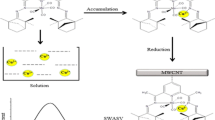Summary
The use of an amalgamated silver-wire electrode, providing a relatively large rate of film area to volume of mercury, seems to present several advantages over the use of the hanging mercury drop electrode (HMDE) for the determination of trace impurities by anodic-stripping voltammetry (ASV). Peak resolution and sensitivity have both been improved by use of the mercury thin-film electrode (MTFE). Preparation, conservation and treatment of the electrode are simple, requiring brief etching of a silver wire with dilute nitric acid, followed by rinsing, drying and direct amalgamation with mercury. The MTFE is stored in mercury, the excess of which is wiped off before use; it is cleaned by anodic-stripping electrolysis at positive potentials. Under these conditions, ASV produces reproducible peak-heights, with excellent dependence on electrolysis time and concentration of impurities. Samples containing nanogram quantities or less of the impurities of interest, are analysed by a four-step procedure: (1) prolonged pre-electrolysis of the supporting electrolyte,in situ in the voltammetric cell, on an auxiliary MTFE; (2) ASV of the supporting electrolyte on a cleaned MTFE; (3) ASV after the dissolution of the sample; (4) ASV after the addition of standards. The method is suitable for the estimation of traces of Zn(II), Cd(II), Tl(I), Pb(II), Sb(III) and Cu(II) in various high-purity reagents. Most impurities have been adequately determined at the 10−9–10−8 M level by the regular procedure, and at the 10−10–10−9 M level may be determined if the preconcentration (electrolysis) time and rates of potential sweep are increased. The only disadvantage of the method is that the overvoltage of hydrogen evolution is lower for the MTFE than the HMDE.
Zusammenfassung
Die Verwendung einer amalgamierten Silberdrahtelektrode mit einer im Vergleich zum Quecksilbervolumen großen Oberfläche bietet offenbar verschiedene Vorteile bei der Bestimmung von Spurenbeimengungen durch Anodic-stripping Voltammetry (ASV) gegenüber einem hängenden Quecksilbertropfen (HMDE). Peakauflösung und Empfindlichkeit wurden mit Hilfe der Quecksilberdünnschicht-Elektrode (MTFE) verbessert. Herstellung, Aufbewahrung und Behandlung solcher Elektroden sind einfach; sie erfordern eine kurze Anätzung eines Silberdrahtes mit verd. Salpetersäure, Spülung, Trocknung und Amalgamierung mit Quecksilber. Diese Elektroden werden in Quecksilber aufbewahrt, dessen Überschuß vor der Verwendung weggewischt wird. Sie werden durch Anodic-stripping-Elektrolyse bei positivem Potential gereinigt. Unter diesen Bedingungen gibt ASV reproduzierbare Peakhöhen, die zu der Elektrolysezeit und der Konzentration der Beimengungen in gutem Abhängigkeitsverhältnis stehen. Proben, die Nanogrammengen solcher Beimengungen enthalten, werden nach einem Vierstufenverfahren analysiert: 1. verlängerte Vorelektrolyse des Trägerelektrolyten mittels einer Hilfs-MTFE im Voltammetriegefäß; 2. ASV des Trägerelektrolyten mit einer gereinigten MTFE; 3. ASV nach Auflösung der Probe; 4. ASV nach Zugabe der Standards. Die Methode eignet sich zur Bestimmung von Spuren Zn(II), Cd(II), Tl(I), Pb(II), Sb(III) und Cu(II) in verschiedenen hochreinen Reagenzien. Die meisten dieser Verunreinigungen wurden in der Größenordnung 10−9 bis 10−8 M mit Hilfe des regulären Verfahrens bestimmt. In der Größenordnung 10−10 bis 10−9 M können sie bei Verlängerung der Anreicherungszeit (elektrolytisch) und Erhöhung des Potentialbereichs bestimmt werden. Der einzige Nachteil des Verfahrens ist, daß die Überspannung zur Wasserstoffentwicklung geringer ist als mit dem hängenden Quecksilbertropfen.
Similar content being viewed by others
References
W. Kemula, Advan. Polarog.1, 105 (1960).
W. Kemula and A. Kublik, Advan. Analyt. Chem. Instrumentation2, 123 (1963).
I. Shain, Part I of Treatise on Analytical Chemistry, I. M. Kolthoff and P. J. Elving, eds., Part I, Vol. 4, Chap. 50. New York: Interscience. 1964.
E. Barendrecht, in Electroanalytical Chemistry, A. J. Bard, ed., Vol. 2, p. 53. New York: Dekker. 1967.
R. Neeb, Inverse Polarographie und Voltammetrie, Weinheim/Bergstr.: Verlag Chemie. 1969.
S. I. Sinyakova and Yu. I. Vainshtein, Metody Analiza Khim.5–6, 5 (1963); Chem. Abstr.61, 1233 g (1964).
A. G. Stromberg and E. A. Zakharova, Zavodsk. Lab.30, 261 (1964) (Engl. transl.).
E. D. Moorhead and W. H. Doub, Jr., Analyt. Chemistry49, 199 (1977).
K. W. Gardiner and L. B. Rogers, Analyt. Chemistry25, 1393 (1953).
Y. Israel, Talanta13, 1113 (1966).
Author information
Authors and Affiliations
Rights and permissions
About this article
Cite this article
Israel, Y., Ofir, T. & Rezek, J. Determination of trace impurities in high-purity reagents by mercury thin-film anodic-stripping voltammetry. Mikrochim Acta 69, 151–163 (1978). https://doi.org/10.1007/BF01196989
Received:
Issue Date:
DOI: https://doi.org/10.1007/BF01196989



